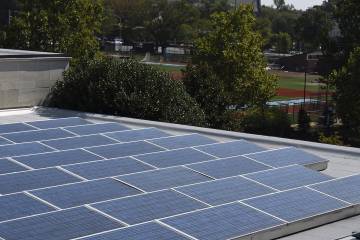Greenhouse gas emissions at Johns Hopkins have been on a steady decline since the university set a goal in 2009 of a 51% reduction by 2025.
A big drop last year—a 14% decrease from 2020 to 2021—helped reach an overall reduction of 39% since 2008. Continuing this momentum, the university expects to meet its original goal by the end of June 2022, three years early.
Detailing this accomplishment and many other sustainability efforts across the university, the JHU Office of Sustainability just released its 2022 Annual Sustainability Report. Specifically, the report highlights both the university's recent successes in combatting climate change and how it is setting the course for the future with the development of a new comprehensive Sustainability Plan.
How did we get here?
To put the numbers in perspective, the emissions reductions over the last year are equivalent to taking 11,048 cars off the road.
Years of efficiency upgrades and conservation measures including LED lighting projects, heating and cooling system retrofits, and the installation of solar panels and combined heat and power plants on several of JHU's campuses received a boost this year when JHU's solar agreement with Constellation Energy went into effect.
Under the 15-year agreement, which began on April 1, 2021, more than 80% of the university's electricity will come from renewable sources, drastically reducing the institution's carbon footprint. The agreement was the largest among any single university nationally at the time of its signing and is the largest renewable energy agreement from a Maryland institution. The renewable energy will come from the construction of the Skipjack Solar Center, a new 175-megawatt solar facility in Charles City County, Virginia, that includes over 500,000 solar panels.
"As a leader in higher education and a regional anchor institution, it is our responsibility to address ambitious climate action," said Julian Goresko, JHU's sustainability director. "This historic agreement caps a decade-plus of progress in climate change mitigation and gives us a foundation to build upon for the future."
Where are we going?
The report also covers the development of the university's new Sustainability Plan, which by spring 2023 will establish an overarching framework for the next decade and beyond—laying out goals, strategies, and metrics through 2030. A critical piece of this is developing a roadmap to carbon neutrality, while also establishing strategies for climate change adaptation across JHU's campuses.
"Our updated Sustainability Plan will set JHU's goals even higher and challenge our community to find creative and collaborative solutions that better support the intersection of sustainability, research and education, and community partnerships," Laurent Heller, senior vice president for finance and administration, wrote in an introductory letter for the report.
Guiding the creation of the Sustainability Plan is a series of overarching committees made up of students, faculty, staff, and external community members. Working groups are tackling topics such as decarbonization, climate resilience, and high-performance and healthy buildings, while advisory groups give counsel on research and academics, business and operations, and surrounding community engagement.

Even as the plan is being developed, sustainability efforts continue. Keeping emissions levels in check as the university grows requires prioritizing efficiency in new construction. For example, the Hopkins Student Center and SNF Agora Building, both under construction on the Homewood Campus, are targeting Leadership in Energy and Environmental Design, or LEED, Platinum certification.
Decreasing greenhouse gas emissions also requires increased efficiency in existing buildings. Laboratories typically consume 5-10 times more energy per square foot than office buildings do. As part of the JHU Green Labs Initiative, more than 15 university laboratory groups are in the process of acquiring My Green Lab certification, which estimates the potential for energy reductions up to 30%.
The annual report highlights these projects, as well as other inspiring initiatives and stories from across the university, which have the potential to be scaled up for greater impact.
"From field classes on sustainable food systems to the electrification of our shuttles, the report shows the breadth and diversity of the sustainability work being accomplished at JHU and the many individuals who make daily contributions," Goresko said.
Posted in Science+Technology, University News, Community
Tagged office of sustainability, emissions










